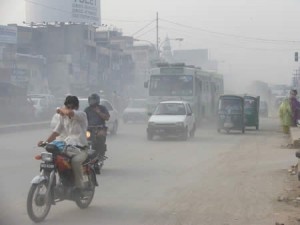Delhi overtakes Beijing as world’s most air-polluted city
08 May 2014
Delhi is the filthiest city in the world when it comes to air quality, having overtaken Beijing in this respect, according to a study released by the United Nations' World Health Organisation (WHO) on Wednesday.
 The 2014 version of the Ambient Air Pollution (AAP) database contains results of outdoor air pollution monitoring from almost 1,600 cities in 91 countries.
The 2014 version of the Ambient Air Pollution (AAP) database contains results of outdoor air pollution monitoring from almost 1,600 cities in 91 countries.
In a reflection of the rock-bottom priority that India's politicians and planners give to the environment and thereby to the country's economic sustainability, the study says as many as 13 of the dirtiest 20 cities in the world were in India, with Delhi, Patna, Gwalior and Raipur in the top four spots.
Mumbai has escaped making the top of the list – which might surprise residents of the country's financial capital, who know they are breathing filthy air and suffering from related diseases.
Perhaps being a coastal city helps disperse Mumbai's pollution a little more than inland towns, even if it is depressing that one can't see the horizon even from the sea shore thanks to smog.
The Delhi National Capital Region (NCR) has the highest concentration of PM2.5, or particulate matter measuring less than 2.5 microns – a form of air pollution which is considered the most serious. It had an annual average of 153 micrograms of PM2.5 particles per cubic metre.
This form of concentration consists of tiny particles that put people at additional risk of respiratory diseases and other health problems, the WHO said.
The situation is so bad in Delhi that its air has PM2.5 concentrations of 153 micrograms and PM10 concentrations of 286 micrograms - much more than the permissible limits.
In comparison, Beijing, which was once considered one of the most polluted cities, has PM2.5 concentration of 56 micrograms and PM10 concentration of 121 micrograms.
Air quality is represented by annual mean concentration of fine particulate matter (PM10 and PM2.5, particles smaller than 10 or 2.5 microns). Apart from respiratory diseases, these particles also put city dwellers at a high risk of developing cancer, stroke, and heart diseases.
The database covers the period from 2008 to 2013, with the majority of values for the years 2011 and 2012.
Air pollution killed about 7 million people in 2012, making it the world's single biggest environmental health risk, the WHO had said last month.
Beijing, notorious for the smog that has prompted some Anglophone residents to dub it "Greyjing", was in 77th place with a PM2.5 reading of 56, a little over one-third of Delhi's pollution level.
WHO experts said the Chinese data was from 2010, the most recent year made available to them by China. But Beijing's city government began publishing hourly PM2.5 data in January 2012.
At the cleaner end of the table, 32 cities reported a PM2.5 reading of less than 5. Three-quarters of those were Canadian, including Vancouver; one was Hafnarfjordur in Iceland; and the other seven were American.
WHO experts insisted the survey was not intended to name and shame the dirtiest cities, since the cities involved were volunteering the information to try to help clean themselves up.
Maria Neira, WHO director for public Health, Environmental and Social Determinants of Health, rejected any suggestion that China might be cheating and said it was becoming much more sophisticated about collecting air pollution data, with a new push to clean up the big cities.
Overall, the survey of found that nearly 90 per cent of people in urban centres breathe air that fails to meet levels deemed safe; and about half of the world's urban population is exposed to pollution at least 2.5 times higher than it recommends.
Air quality was poorest in Asia, followed by South America and Africa.
"Too many urban centres today are so enveloped in dirty air that their skylines are invisible," said Dr Flavia Bustreo, the WHO's assistant director-general for family, children and women's health. "Not surprisingly, this air is dangerous to breathe."






















